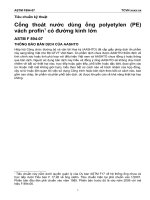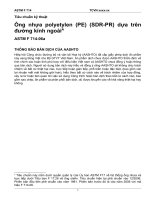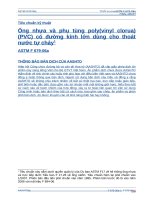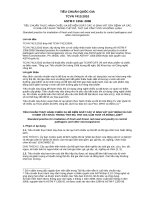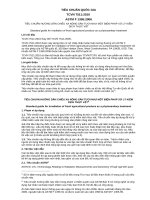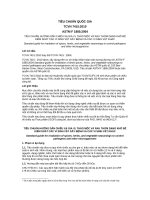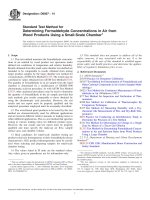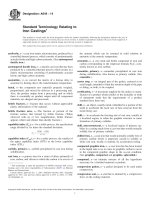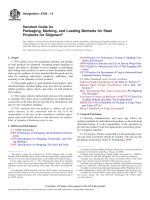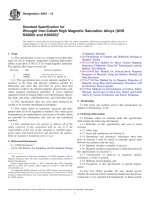Astm f 477 14
Bạn đang xem bản rút gọn của tài liệu. Xem và tải ngay bản đầy đủ của tài liệu tại đây (111.58 KB, 4 trang )
Designation: F477 − 14
Standard Specification for
Elastomeric Seals (Gaskets) for Joining Plastic Pipe1
This standard is issued under the fixed designation F477; the number immediately following the designation indicates the year of original
adoption or, in the case of revision, the year of last revision. A number in parentheses indicates the year of last reapproval. A superscript
epsilon (´) indicates an editorial change since the last revision or reapproval.
This standard has been approved for use by agencies of the U.S. Department of Defense.
Cracking (Withdrawn 2007)3
D573 Test Method for Rubber—Deterioration in an Air
Oven
D883 Terminology Relating to Plastics
D1149 Test Methods for Rubber Deterioration—Cracking in
an Ozone Controlled Environment
D1229 Test Method for Rubber Property—Compression Set
at Low Temperatures
D1349 Practice for Rubber—Standard Conditions for Testing
D1414 Test Methods for Rubber O-Rings
D1415 Test Method for Rubber Property—International
Hardness
D1566 Terminology Relating to Rubber
D2240 Test Method for Rubber Property—Durometer Hardness
F913 Specification for Thermoplastic Elastomeric Seals
(Gaskets) for Joining Plastic Pipe
2.2 NSF Standards:
Standard No. 14 for Plastic Piping Components and Related
Materials4
Standard No. 61 for Drinking Water Systems ComponentsHealth Effects4
1. Scope*
1.1 This specification covers elastomeric seals (gaskets)
used to seal the joints of plastic pipe used for gravity,
low-pressure, and high-pressure applications. This refers to
push-on joints which require no internal or external pressure to
effect the initial seal.
1.2 Requirements are given for natural or synthetic rubber
gaskets, or a combination of both.
1.3 The text of this specification references notes, footnotes,
and appendixes which provide explanatory material. These
notes and footnotes (excluding those in tables and figures) shall
not be considered as requirements of the specification.
1.4 The values stated in inch-pound units are to be regarded
as standard. The values given in parentheses are mathematical
conversions to SI units that are provided for information only
and are not considered standard.
1.5 The following precautionary caveat pertains only to the
test method portion, Section 7, of this specification: This
standard does not purport to address all of the safety concerns,
if any, associated with its use. It is the responsibility of the user
of this standard to consult and establish appropriate safety and
health practices and determine the applicability of regulatory
limitations prior to use.
3. Terminology
3.1 Definitions—Terms relating to rubber or elastomer shall
be as defined in Terminology D1566. Terms relating to plastics
shall be as defined in Terminology D883.
2. Referenced Documents
2.1 ASTM Standards:2
D395 Test Methods for Rubber Property—Compression Set
D412 Test Methods for Vulcanized Rubber and Thermoplastic Elastomers—Tension
D471 Test Method for Rubber Property—Effect of Liquids
D518 Test Method for Rubber Deterioration—Surface
3.2 Definitions of Terms Specific to This Standard:
3.2.1 sealing portion of the gasket—any part of the elastomeric material that is in deformation which provides seals
between the bell and spigot of adjoining sections of pipe.
4. Composition and Manufacture
4.1 All gaskets shall be extruded or molded in such a
manner that any cross section will be dense, homogeneous, and
free of porosity, blisters, pitting, or other defects that make
1
This specification is under the jurisdiction of ASTM Committee F17 on Plastic
Piping Systems and is the direct responsibility of Subcommittee F17.20 on Joining.
Current edition approved Sept. 15, 2014. Published December 2014. Originally
published as approved in 1976. Last previous edition approved in 2010 as
F477 – 10. DOI: 10.1520/F0477-14.
2
For referenced ASTM standards, visit the ASTM website, www.astm.org, or
contact ASTM Customer Service at For Annual Book of ASTM
Standards volume information, refer to the standard’s Document Summary page on
the ASTM website.
3
The last approved version of this historical standard is referenced on
www.astm.org.
4
Available from NSF International, P.O. Box 130140, 789 N. Dixboro Rd., Ann
Arbor, MI 48113-0140, .
*A Summary of Changes section appears at the end of this standard
Copyright © ASTM International, 100 Barr Harbor Drive, PO Box C700, West Conshohocken, PA 19428-2959. United States
1
F477 − 14
TABLE 1 Physical Requirements for Elastomeric Seals for
Plastic Pipe
them unfit for the use intended. The gasket shall be fabricated
from a high-grade elastomer material. The basic polymer shall
be natural rubber, synthetic rubber, a blend of both, or a
thermoplastic elastomer, meeting the requirements prescribed
in Sections 5 and 6.
Tests
4.2 Where a splice is used in the manufacture of the gasket,
the strength shall be such that the gasket shall withstand 100 %
elongation over the part of the gasket which includes the splice
with no visible separation of the splice. While in a stretched
position the gasket shall be rotated in the spliced area a
minimum of 180° in each direction in order to inspect for
separation. In addition, any portion of the splice shall be
capable of passing a bend test without visible separation. The
bend test for circular gaskets is defined as wrapping the portion
of the unstretched gasket containing the splice a minimum of
180° and a maximum of 270° around a rod of a diameter equal
to the cross section diameter of the gasket.
Original Properties:
Tensile strength, min, psi (MPa)
Elongation, min, %
Hardness, Type A durometer
Low-temperature hardness, Type A durometer, max increase, points
Compression set, max %
Ozone resistance
Accelerated Aging (Air Oven Test):
Decrease in tensile strength, max % of
orignal
Decrease in elongation, max % of original
Hardness, Type A durometer, max increase,
points
After Water Immersion:
Change in volume max %
5. Dimensions and Tolerances
Low-Head
Application
(Below 150
kPa or 50-ft
Head)
High-Head
Application
(150 kPa or
50-ft Head
and Above)
1200 (8.3)
325
40 to 60
15
2000 (13.8)A
400
40 to 60
15
25
no cracks
20
no cracks
15
15
20
8
20
8
5
5
A
For EPDM and nitrile seals, tensile strength min. psi (MPa) is 1500 (10.3).
5.1 When in its final assembled position, the gasket shall not
be stretched more than 30 % of its original circumference.
TABLE 2 Physical Requirements for Thermoplastic Elastomeric
Seals for Plastic Pipe
NOTE 1—Excessive stretch may have deleterious effect on rubber
gaskets, the minimum stretch compatible with the proper performance of
the gasket should be used at all times.
5.2 The gaskets shall conform to the dimensions specified
by the manufacturer of the pipe or fittings, with which the
gaskets are to be used, with a Rubber Manufacturers’ Association Class 3 tolerance on all cross section dimensions, and
61 % on all diametrical dimensions, unless otherwise agreed
upon by the pipe or fitting manufacturer and the purchaser.
Original Properties:
Tensile strength, min, psi (MPa)
100 % modulus, min, psi (MPa)
Elongation, min, %
Hardness, Type A durometer
Low-temperature hardness, Type A
durometer, max increase, points
Compression set, max %
Ozone resistance
Accelerated Aging (Air Oven Test):
Decrease in tensile strength, max % of
original
Decrease in elongation, max % of original
Hardness, Type A durometer, max change,
points
After Water Immersion:
Change in volume max %
Force Decay
Remaining stress, min,%
5.3 For molded gaskets or gasket material, the permissible
flash shall be a maximum of +0.032 in. (0.80 mm). Maximum
mold mismatch shall not exceed 0.010 in. (0.25 mm).
6. Physical Requirements
6.1 Standard Gasket requirements—The sealing portion of
the gaskets shall comply with the physical requirements listed
in Table 1 for thermoset elastomers or Table 2 for thermoplastic elastomers, when tested in accordance with the methods in
Section 7.
6.1.1 Oil resistant gaskets requirements—The sealing portion of the gaskets shall not contain less than 50% by volume
oil resistant polymer and shall meet the physical requirements
listed in Table 3, when tested in accordance with the methods
in Section 7.
Low-Head
Application
(Below 150
kPa or 50-ft
Head)
High-Head
Application
(150 kPa or
50-ft Head
and Above)
435 (3.0)
200 (1.4)
350
40 to 70
10
500 (3.5)
280 (1.9)
350
40 to 70
10
25
no cracks
20
no cracks
15
15
15
5
15
5
4
40
4
50
thermoplastic elastomers. Gaskets are required to have the
Type A durometer hardness specified, 6 5 points.
NOTE 2—Some gaskets incorporate a high durometer elastomeric or
nonelastomeric, that is, metal or plastic material, as a reinforcement or
retaining feature, or both. These materials do not alter the physical
properties of the sealing portion of the gasket and should not be tested as
such, or expected to meet the material requirements listed in Table 1.
NOTE 3—The gasket manufacturer should be assured that materials
used for retaining or reinforcement, or both, do not encroach upon the
sealing surfaces of the gasket, and have physical properties which ensure
adequate longevity for the anticipated usage.
6.2 Elastomer compounds must be non-crazing to pipe. The
gasket in the cured state shall not cause craze marks, pits, or
blisters when in contact with the plastic pipe. Staining of the
plastic pipe in the area of gasket contact is acceptable. Test in
accordance with 7.9 to qualify elastomer compound for pipe
made from the plastic polymer in question.
6.3 Where the particular joint design utilizing a rubber
gasket dictates the use of a lubricant to facilitate assembly, the
lubricant shall be of such composition which will in no way
damage the gasket or pipe due to prolonged exposure.
6.1.2 Hardness—The Type A durometer average hardness
specified by the manufacturer shall be within the range given in
Table 1 and Table 3 for thermoset elastomers or Table 2 for
2
F477 − 14
TABLE 3 Physical Requirements for Oil Resistant Elastomeric
Seals for Plastic Pipe
Low-Head
Application
(Below 150
kPa or 50-ft
Head)
Original Properties:
Tensile strength, min, psi (MPa)
Elongation, min, %
Hardness, Type A durometer
Low-temperature hardness, Type A
durometer, max increase, points
Compression set, max %
Ozone resistance
Accelerated Aging (Air Oven Test):
Decrease in tensile strength, max % of
original
Decrease in elongation, max % of original
Hardness, Type A durometer, max change,
points
After Water Immersion:
Change in volume max %
Liquid immersion IRM 903 Oil Max %
volume change
7.5 Compression Set—Determine the compression set in
accordance with Method B of Test Methods D395 or D1414 for
O-rings. Test temperature and time shall be 22 h at 158 6
4°F(70 6 2°C ), with a 25 % deflection of the test specimens.
(See Test Method D1229.)
High-Head
Application
(150 kPa or
50-ft Head
and Above)
1200 (8.3)
325
40 to 60
15
1500 (10.3)
350
40 to 60
15
25
no cracks
20
no cracks
15
15
20
8
20
8
10
50
10
50
7.6 Accelerated Aging—Age specimens for physical test in
accordance with Test Method D573. (See Test Method D518.)
7.6.1 Age physical test specimens for 96 h at 158 6 4°F (70
6 2°C).
7.7 Water Immersion—Determine the change in volume in
accordance with Test Method D471 or Test Methods D1414 for
O-rings.
7.7.1 The temperature shall be 1586 4°F (70 6 2°C), and
the immersion period shall be 48 h.
7.7.2 Immediately after removal from the water, blot the
specimens, weigh, and calculate the volume increase in accordance with Test Method D471.
7.8 Oil Immersion—Determine resistance to oil by calculating % volume change after immersing product specimen in
ASTM IRM 903 oil for 212 6 4° F (70 h at 100 6 2° C) in
accordance with Test Method D471.
7. Test Methods
7.1 Perform laboratory tests to determine the physical properties of the gaskets to be furnished under this specification on:
(1) the finished product as supplied, (2) test specimens taken
from the finished product, or (3) from specimens of fabrication
of the same elastomeric compound, and in accordance with the
appropriate ASTM standard. (See Practice D1349.)
7.9 Ozone Resistance—Determine the gasket’s resistance to
ozone in accordance with Test Method D1149.
7.9.1 Conduct test for 70 h in 50 pphm concentration at 104
6 4°F (40 6 2°C) with specimens stressed to 20 % extension.
7.10 Determine elastomer compound effect on pipe (6.2) by
the following procedure:
7.10.1 The specimen shall be a gasket or a part of a gasket
that will fit within the test fixture shown in Fig. 1.
7.10.2 The fixture for the test shall be as described for the
compression set test in Method B of Test Methods D395 with
a plate of plastic adjoining the interior surfaces of the compression plates (see Fig. 1).
7.10.3 Make liner bearing plates of plastic with a minimum
wall thickness of 0.120 in. (3.0 mm) to fit the interior surfaces
of the fixture’s compression plates.
7.2 Tensile Strength and Elongation—Determine tensile
strength, 100 % modulus, and elongation in accordance with
Test Methods D412 or D1414 for O-rings.
7.3 Hardness—Determine the durometer, Type A, of the
gasket in accordance with Test Method D2240 or Test Methods
D1414 for O-rings. (See Test Method D1415.)
7.4 Low-Temperature Hardness—Measure the durometer,
Type A, of the gasket in accordance with Test Method D2240
or Test Methods D1414 for O-rings after conditioning for 22 h
at +14 6 4°F (−10 6 2°C) to determine the change in hardness.
FIG. 1 Device for Test of Elastomeric Compound Effect on Plastic
3
F477 − 14
9. Certification
7.10.3.1 Form the plastic bearing plate from like plastic
material by cutting and pressing pipe at a workable stressrelieving temperature not to exceed that required to form a gasket
race.
7.10.4 Set the test apparatus up as in the compression set
test in accordance with Method B of Test Methods D395 with
the plastic bearing plate in place.
7.10.5 Age the specimens under load for 96 h at 158 6 4°F
(70 6 2°C).
7.10.6 Let the specimens cool in the fixture for 24 h at 70 to
77°F (21 to 25°C).
7.10.7 Upon release, inspect the plastic bearing plate surface that has been in contact with the elastomeric compound
for cracks, craze marks, pits, or blisters (6.2).
9.1 At the option of the purchaser, certified copies of test
reports on the elastomer from which the shipment of gaskets
was made shall be furnished by the gasket supplier.
10. Storage
10.1 The rubber gaskets shall be stored in a cool, clean,
shaded place. The preferred temperature is 70°F (21°C) or
lower.
11. Marking
11.1 The markings shall include the gasket manufacturer’s
name or symbol, gasket size, and manufacturer’s code to
differentiate between high- and low-head gaskets.
7.11 Force Decay (Stress Relaxation)—Determine force
decay in accordance with thermoplastic elastomer force decay
test as outlined in Specification F913.
11.2 Any additional marking or color designation shall be as
agreed upon by the pipe and gasket manufacturer.
8. Rejection
12. Keywords
8.1 The rubber gaskets shall be subject to rejection whenever they show surface checking, weathering, or other deterioration prior to installation.
12.1 elastomeric; gaskets; plastic pipe; push-on joint ;
rubber; seals; synthetic; thermoplastaic elastomer
SUPPLEMENTARY REQUIREMENTS
POTABLE WATER REQUIREMENT
This requirement applies whenever a Regulatory Authority or user calls for product to be used to
convey or to be in contact with potable water.
Standard No. 14 by an acceptable certifying organization when
required by the regulatory authority having jurisdiction.
S1. Products intended for contact with potable water shall
be evaluated, tested and certified for conformance with ANSI/
NSF Standard No. 61 or the health effects portion of NSF
SUMMARY OF CHANGES
Committee F17 has identified the location of selected changes to this standard since the last issue (F477–10)
that may impact the use of this standard.
(1) 3.2 and 3.2.1 were added.
ASTM International takes no position respecting the validity of any patent rights asserted in connection with any item mentioned
in this standard. Users of this standard are expressly advised that determination of the validity of any such patent rights, and the risk
of infringement of such rights, are entirely their own responsibility.
This standard is subject to revision at any time by the responsible technical committee and must be reviewed every five years and
if not revised, either reapproved or withdrawn. Your comments are invited either for revision of this standard or for additional standards
and should be addressed to ASTM International Headquarters. Your comments will receive careful consideration at a meeting of the
responsible technical committee, which you may attend. If you feel that your comments have not received a fair hearing you should
make your views known to the ASTM Committee on Standards, at the address shown below.
This standard is copyrighted by ASTM International, 100 Barr Harbor Drive, PO Box C700, West Conshohocken, PA 19428-2959,
United States. Individual reprints (single or multiple copies) of this standard may be obtained by contacting ASTM at the above
address or at 610-832-9585 (phone), 610-832-9555 (fax), or (e-mail); or through the ASTM website
(www.astm.org). Permission rights to photocopy the standard may also be secured from the Copyright Clearance Center, 222
Rosewood Drive, Danvers, MA 01923, Tel: (978) 646-2600; />
4
